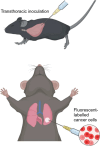Function of alveolar macrophages in lung cancer microenvironment
- PMID: 38720352
- PMCID: PMC11077793
- DOI: 10.1186/s41232-024-00335-4
Function of alveolar macrophages in lung cancer microenvironment
Abstract
Background: Cancer tissues contain a wide variety of immune cells that play critical roles in suppressing or promoting tumor progression. Macrophages are one of the most predominant populations in the tumor microenvironment and are composed of two classes: infiltrating macrophages from the bone marrow and tissue-resident macrophages (TRMs). This review aimed to outline the function of TRMs in the tumor microenvironment, focusing on lung cancer.
Review: Although the functions of infiltrating macrophages and tumor-associated macrophages have been intensively analyzed, a comprehensive understanding of TRM function in cancer is relatively insufficient because it differs depending on the tissue and organ. Alveolar macrophages (AMs), one of the most important TRMs in the lungs, are replenished in situ, independent of hematopoietic stem cells in the bone marrow, and are abundant in lung cancer tissue. Recently, we reported that AMs support cancer cell proliferation and contribute to unfavorable outcomes.
Conclusion: In this review, we introduce the functions of AMs in lung cancer and their underlying molecular mechanisms. A thorough understanding of the functions of AMs in lung cancer will lead to improved treatment outcomes.
Keywords: INHBA; Activin A; Alveolar macrophage; Cancer microenvironment; Lung cancer; Tissue-resident macrophage.
© 2024. The Author(s).
Conflict of interest statement
The authors declare that they have no competing interests.
Figures



Similar articles
-
Tissue-Resident Macrophages in Cancer: Friend or Foe?Cancer Med. 2024 Nov;13(21):e70387. doi: 10.1002/cam4.70387. Cancer Med. 2024. PMID: 39494816 Free PMC article. Review.
-
β-Catenin signaling in alveolar macrophages enhances lung metastasis through a TNF-dependent mechanism.JCI Insight. 2023 Apr 24;8(8):e160978. doi: 10.1172/jci.insight.160978. JCI Insight. 2023. PMID: 37092550 Free PMC article.
-
In vivo induction of activin A-producing alveolar macrophages supports the progression of lung cell carcinoma.Nat Commun. 2023 Jan 17;14(1):143. doi: 10.1038/s41467-022-35701-8. Nat Commun. 2023. PMID: 36650150 Free PMC article.
-
The roles of tissue resident macrophages in health and cancer.Exp Hematol Oncol. 2024 Jan 16;13(1):3. doi: 10.1186/s40164-023-00469-0. Exp Hematol Oncol. 2024. PMID: 38229178 Free PMC article. Review.
-
Alveolar macrophages in lung cancer: opportunities challenges.Front Immunol. 2023 Sep 26;14:1268939. doi: 10.3389/fimmu.2023.1268939. eCollection 2023. Front Immunol. 2023. PMID: 37822933 Free PMC article. Review.
References
Publication types
Grants and funding
LinkOut - more resources
Full Text Sources

